Eleocharis mamillata subspecies mamillata
Eleocharis mamillata sensu stricto
This plant is not yet known in UK! It should be looked for anywhere, as an early colonising, but ephemeral, species.
Thomas Gregor writes (pers. comm.) “Eleocharis mamillata is not a rare plant in Central Europe. But it occurs very patchily and not for long in any one place. It is able to reach new ponds, especially those dug by nature conservation groups. It is probably transported by ducks. I would not be surprised if it turned up in England, for instance somewhere in the south. ... Eleocharis austriaca and E. mamillata produce huge amounts of seed. They do not seem to invest much energy in lasting vegetative organs. I regard them as pioneer species”.
NB: The photographs below are from specimens originating in Germany. I am very grateful to Mike Wilcox for sending material collected by Thomas Gregor. I am also grateful to the latter for exchanges on the status of this taxon.
Use the linked "⇑" up-arrows with each topic header to get back here, or use the 'Top' button which appears in the lower-right corner when you're further down the page.
Links to all pages are at the bottom of the page.
Studies abroad (e.g. Gregor (2003): see References, below) suggest that intermediates connect E. mamillata subspecies mamillata with subspecies ⇒austriaca, which is more characteristic of upland river-banks and ox-bow pools, very often with some calcareous influence in the water.
British plants referable to austriaca tend towards the intermediate zone between these two in some characters, but thus far no evidence has arisen of true subspecies mamillata. Work is proceeding on UK plants.
Subspecies ⇒austriaca is distinguished by its narrower-based and taller style-base, and nut with a usual count of five bristles (six here).
Overview ⇑
Like austriaca in most features:
➢ stems pale green, circular in section, flimsy and brittle
➢ epidermal peel show 'open' structure, like austriaca
➢ basal sheaths not red/purple flushed at base (contrast palustris)
➢ patch-forming (like palustris and uniglumis, but unlike the tufted multicaulis), or even sheet-forming
➢ spikelets typically conical but can be ovoid (then similar to palustris)
➢ spikelets typically many-flowered – at least 20 and often more flowers/nuts
➢ the two basal glumes are sterile (enclosing no flower or fruit), similar in size and shape, short, and typically each encloses just half the spikelet-base with no overlap (like palustris, but contrast uniglumis)
➢ stigma 2-forked (as in austriaca, palustris and uniglumis; contrast multicaulis and the three smaller species which are 3-forked)
➢ ripe nut has a persistent style-base, distinctly swollen (more so than austriaca), and constricted at the attachment to the nut with a 'neck' (wide as in palustris, multicaulis, and uniglumis, but lower in height than these; contrast quinqueflora and the smaller species which have the style-base confluent with the nut)
➢ nut has usually six bristles at its base, less often five (typical for austriaca) or other counts
➢ usually emergent from shallow or deeper water, often from silt over a gravelly substrate; characteristic of artificial ponds, usually with base-poor waters
Stem sections ⇑
➢ see the page ⇒ID:palustris/austriaca for discussion.
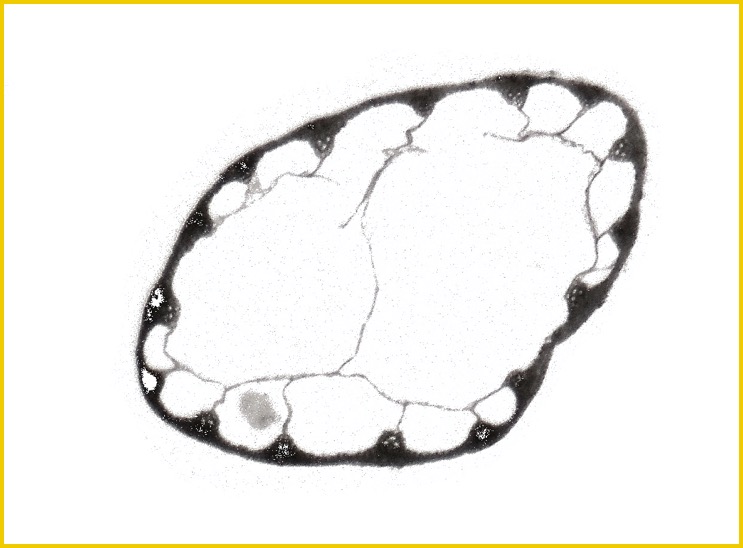
stem sections (from dried specimen: not recovered circular shape)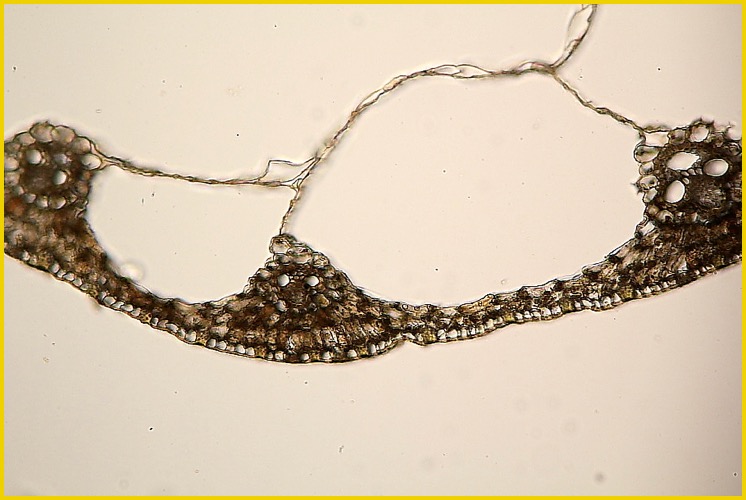
Epidermis ⇑
➢ very like austriaca: perhaps even more ‘open’. Note well-separated fibre-bundles with wide strips of epidermal cells in 3-7 ranks. It is this relative lack of fibre-bundles that makes the stems britlle rather than flexuous.
(See ⇒ID:palustris/austriaca for discussion.)
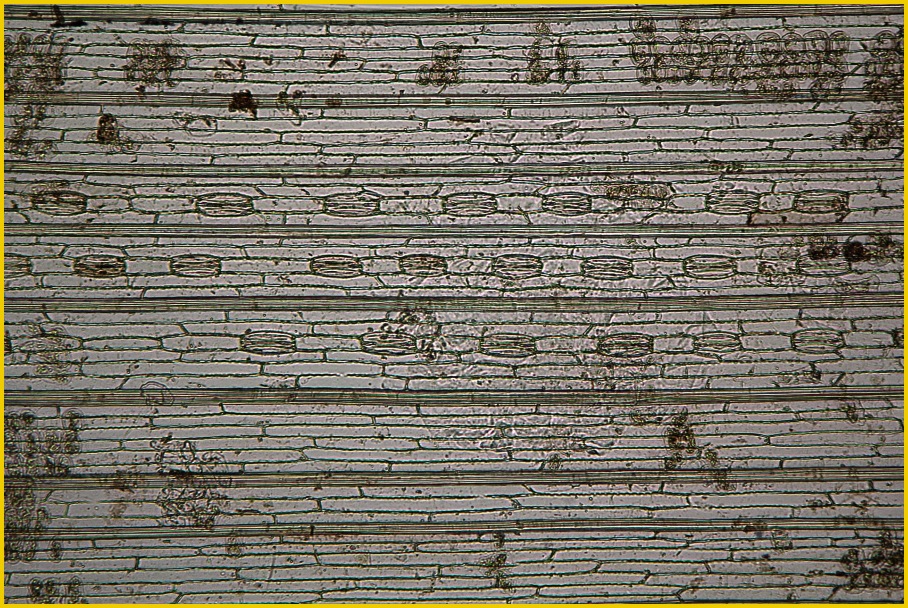
epidermal peel
Stomata ⇑
➢ like austriaca, generally shorter than in palustris ssp. vulgaris; mean 58 μm (n=20) in this specimen
➢ guard cells protrude beyond the subsidiary cells (as in austriaca, unlike palustris), (“like a hot-dog”)

stomata have the guard cells protruding (like austriaca, unlike palustris)
Flowers ⇑
➢ stigma 2-forked
➢ perianth bristles usually 6.
Nuts
➢ style-base (stylopodium) is persistent, and strongly swollen, but lower in profile than in palustris (and the other larger species)
➢ style-base has a constriction (‘neck’) at its junction with the nut
➢ vs. austriaca: much more reminiscent of palustris ssp. vulgaris
ripe nuts showing swollen style-base with strongly-constricted ‘neck’,
perianth bristles (with downcurved hooks), and persistent filaments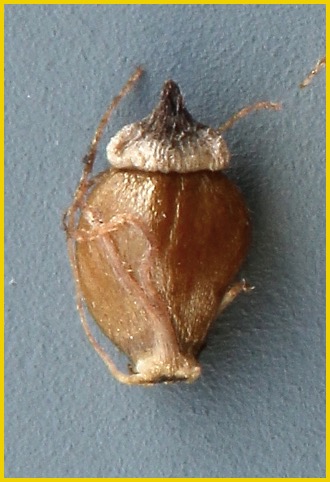
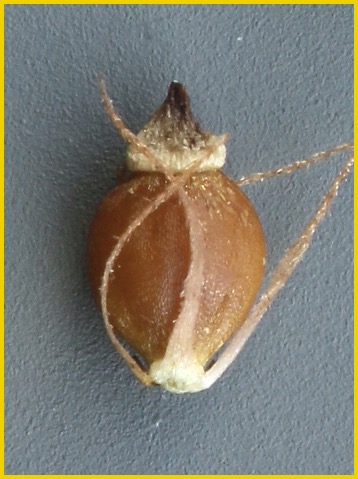

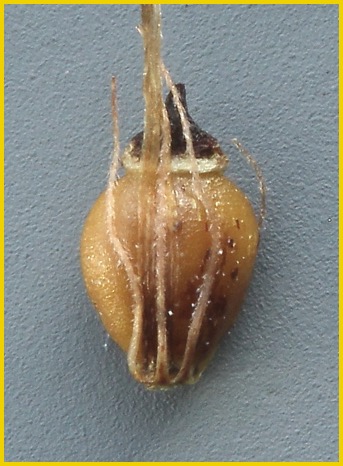
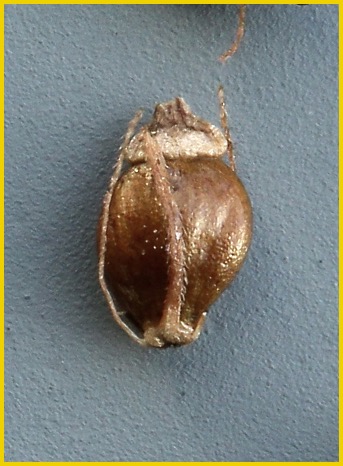
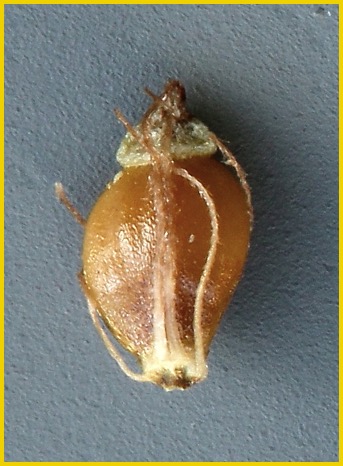
Habitat ⇑
➢ Standhede & Dahlgren (1968) say “small stagnant ponds etc. without competing vegetation in +/- oligotrophic, non-calcareous areas”. See also Thomas Gregor's comments at the top of the page.
Frequency & range ⇑
➢ not known in UK; local in central and northern Europe
➢ rather ephemeral; an early colonist and poor competitor: readily eliminated as pools become overgrown
References ⇑
Gregor, Thomas (2003) Eleocharis mamillata – Distribution and Infraspecific Differentiation (Folia Geobotanica 38: 49–64).
This can be downloaded from the following link, under the heading '2003':
http://flora-deutschlands.de/Publikationen/Publikationen_T_Gregor.htm
Strandhede, Sven-Olov (1966) Morphologic Variation and Taxonomy in European Eleocharis, Subser. Palustres. (Opera Botanica 10:2; 1-188).
This can be ordered from:
http://www.koeltz.com/
Strandhede, S-O & Dahlgren, R. (1968) Drawings of Scandinavian Plants 9-10. (Botaniska Notiser 121-1, pp. 1-10).
[I have not found a source for this.]
Links to the other Eleocharis spike-rush pages (also accessible from the sidebar)
Species pages
Separation of similar pairs
Other information
